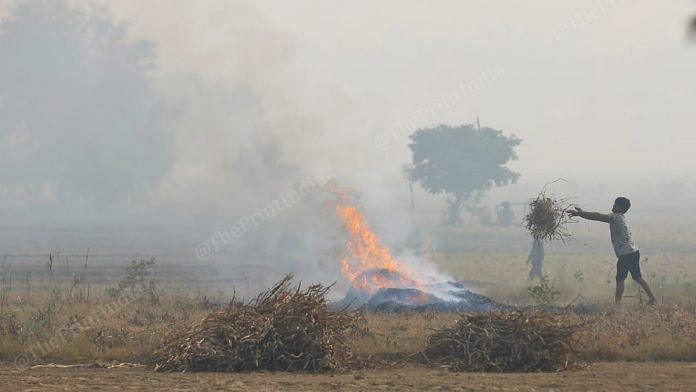New Delhi: Tackling stubble burning in India can reduce prevalence of hypertension or high blood pressure and by extension also save $2.24 billion (more than Rs 16,479 crore) over five years, a new study has found.
Every year, just before the onset of winter, paddy farmers of Punjab and Haryana are faced with the challenge of quickly removing crop stubble left over in their fields after the season’s harvest.
A common practice to remove stubble is to set fire to their fields. However, due to the meteorological conditions of the region, the smoke from the fields does not dissipate. Instead, the pollutants from the fields worsens the air quality levels in several cities in North India including Delhi, Gurgaon, Noida and Ghaziabad.
In the study, researchers from IIT Delhi, Brookings Institution and Ashoka University found that exposure to smoke from crop residue burning can increase the risk of high blood pressure and those over the age of 40 were more vulnerable to it.
Reducing biomass burning would, therefore, prevent loss of 70,000 to 91,000 of human lives every year, the study, published in the SSM – Population Health journal, revealed.
By reducing the disease burden associated with hypertension, a condition that further increases the risk of heart disease and stroke, Indians could save $1.73 to 2.24 billion over five years, according to the researchers.
Therefore, they added, curbing biomass burning will ensure significant health and economic benefits in North India.
While several earlier studies have linked pollution to several health issues, researchers claimed this is the first study to systematically examine this relationship and estimate its economic implications for India.
The study included researchers from AIIMS and Safdarjung Hospital in New Delhi.
Also read: Pusa tablets — the microbial cocktail that gives farmers an alternative to stubble burning
The study
The study used data from the National Family Health Survey (NFHS-IV) 2015-16, which collected data from 188-190 individuals from four states — Punjab, Haryana, Uttar Pradesh and Bihar.
The NFHS-IV provides blood pressure data at the national, state and district level in a population, for women aged 15-49 years and men aged 15-54 years.
The data also includes exposure to fire-events and weather-related factors, such as temperature and rainfall.
The team calculated the number of fire-events within a 100 km radius in the 30 days prior to the collection of the blood pressure data by the NFHS-IV interviewers.
The research team found that people who had been exposed to biomass burning in the past 30 days were more likely to have hypertension or high BP, than those who were not exposed to biomass burning incidents.
“India thus needs effective policies regarding regulation and management of biomass burning. The policy instruments should address the knowledge barrier in adoption of new clean technologies for managing crop residue and they should provide greater financial support for buying new machinery,” the researchers wrote in the study.
“In addition to this farmers should be encouraged to sell their residue for alternative purposes like use of rice pellets for power generation, use of stubble as fodder for cattle etc,” the team added.
They also noted that the policy of zero-tolerance towards crop burning has been found to be ineffective.
Rather, a greater amount of monetary support by the government for renting or buying new machinery, financial incentives for zero-burning and information dissemination about harmful health effects of crop burning to the farmers could help tackle the issue better.
Also read: How Covid has worsened Delhi’s air pollution crisis



